Are you looking for an opportunity to own a little piece of St. Louis history?
Lafayette Square is a glimpse into Victorian St. Louis during its most vibrant years. Brightly colored historic homes overlook the heart of it all: Lafayette Park.
In this guide, we’ll cover what to expect living here, things to do, and an overview of gorgeous real estate in this neighborhood.
City Living at Its Best
This St. Louis City neighborhood is the perfect blend of stylish restaurants, a rich history, and easy interstate access.
It’s steps away from other trendy neighborhoods like Soulard, Tower Grove, Benton Park, and Fox Park.
Living in Lafayette Square, you’ll also be minutes away from Downtown St. Louis, with all the classic attractions like:
- The Gateway Arch
- Busch Stadium
- Ballpark Village
- Enterprise Center
- CityPark
- St. Louis Zoo
- Missouri Botanical Garden
- St. Louis Union station
The beautiful tree-lined streets, Lafayette Park, and the timeless houses are a major draw to this area for visitors and residents alike.
It’s not uncommon to see people taking a stroll, going for a jog, or walking their dogs.
In addition, there are delightful shops and numerous eateries to explore while you walk through this exceptional city neighborhood.
Neighborhood’s Boundaries:
- North: Chouteau Avenue
- South: Interstate 44
- East: Truman Parkway
- West: South Jefferson Avenue
Homes in Lafayette Square
Some of the houses trace their roots back to the pre-Civil War era.
Others were built in the latter half of the 19th century. These trademark homes showcase architectural features such as arched doorways and windows.
The most famous among them are ‘The Painted Ladies’—colorful Victorian homes that face Lafayette Park.
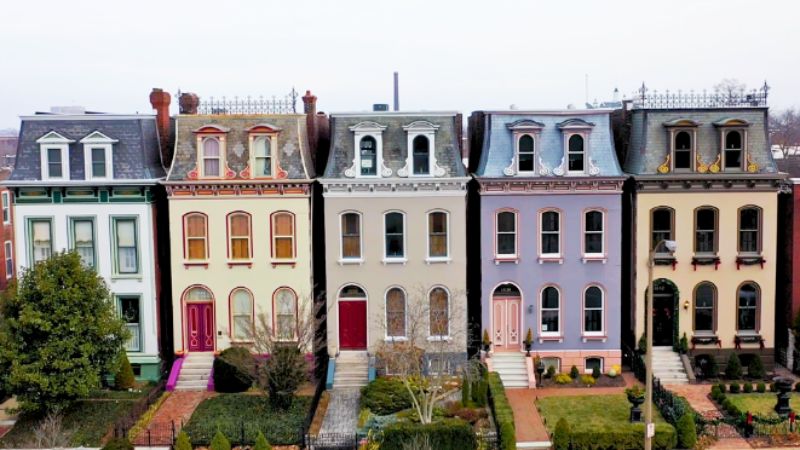
You’ll see beautiful examples of Second Empire architecture and gorgeous Victorian homes.
In addition to the restored single-family homes, there are:
- Multi-family homes
- Up-scale lofts
- Luxury apartments
- Condominiums
Some homes in the area are newly built, seamlessly matching the historic aesthetic.
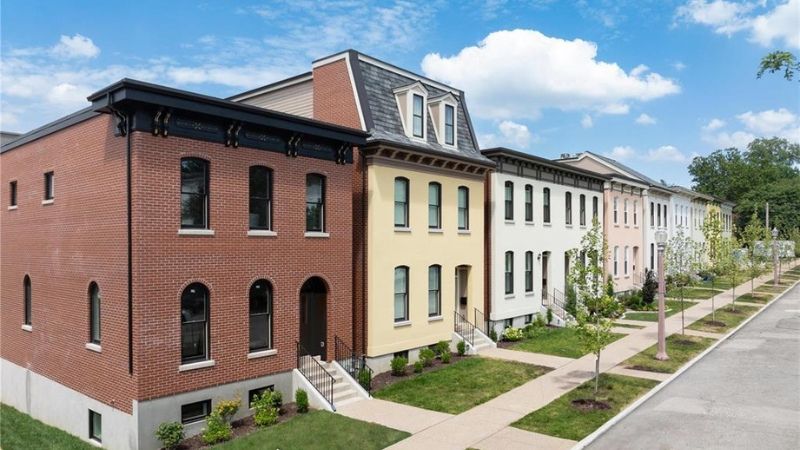
You’ll also find older homes that have been completely renovated inside.
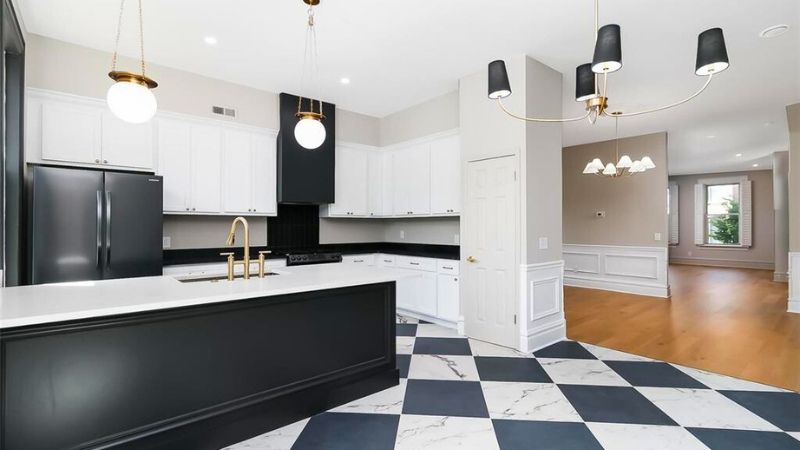
These townhouses were built in 1983:

Condos in Historic Lafayette Square
The Georgian is the largest condo building in the neighborhood. It features 104 converted units.
The Georgian was originally built in 1903 as the City Hospital until it closed in 1985.
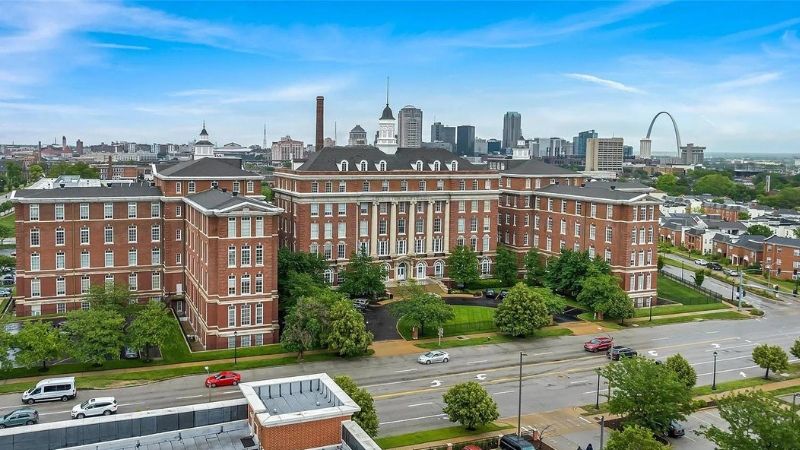
In 2001, the building was placed on the National Registry of Historic Places.
Recent and Upcoming Residential Development
2220 LaSalle at Lafayette Square features 128-unit luxury apartments. It was constructed in 2023 at the southeast corner edge of Lafayette Square, encompassing 12 acres.
There are plans for another apartment complex, The Lagosian Apartments at 2300 LaSalle.
These would include 34 brick townhouse apartments in a style more commonly seen in NYC. Developers are hoping for a summer of 2024 opening.
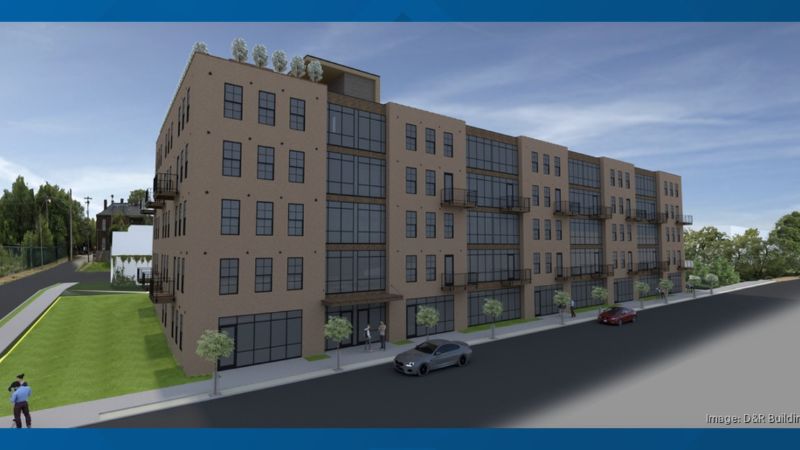
These new apartments are anticipated to energize the local restaurants and small businesses in the area.
Living in a St. Louis City Historic District
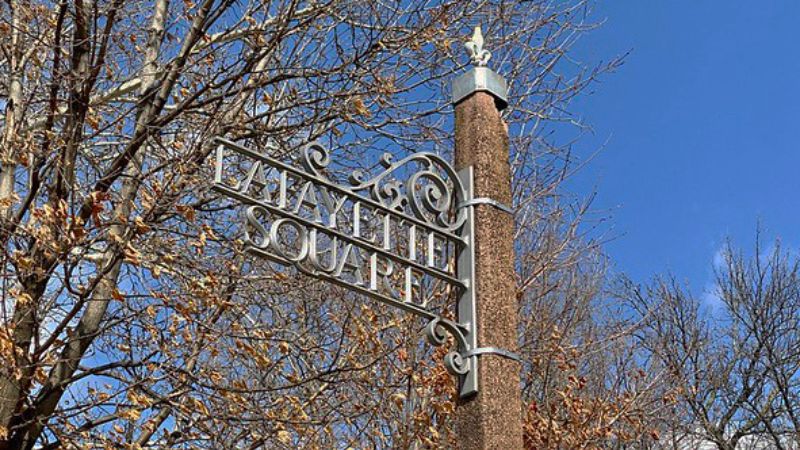
Lafayette Square is one of eight certified local historic districts in St. Louis.
If you’re considering owning a home or business in Lafayette Square, understanding the Historic Code that safeguards the neighborhood’s historic charm is crucial.
If you’re interested in the local regulations, click here. Here are some of the general guidelines:
- Restrictions apply exclusively to building exteriors.
- Public-facing windows must be wood, not vinyl or aluminum.
- All structures visible from the street must be brick.
- Fences must mirror historical styles in the area and adhere to height restrictions.
The Ups and Downs of Owning a Historic Home
Owning a historic home can be rewarding. However, it’s a good idea to do some research before diving in. Especially if you have dreams of “making it your own.”
Not only are you taking on the house’s history, but of anyone who has owned or worked on it before you!
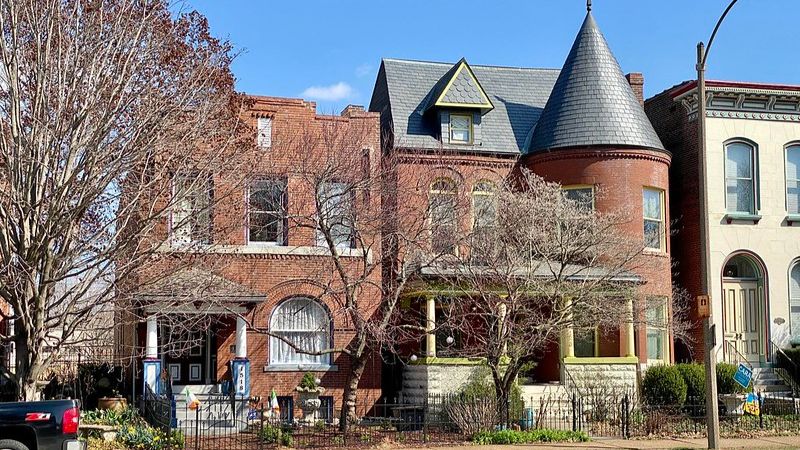
Here are some tips if you’re considering owning an older home:
Use the city’s Address and Property Search to check out recent construction permits, assessments, taxes, etc on the property you’re considering.
Research if there are any grants or loans available for historic home restoration. Here’s a link to a list of organizations to get you started!
Talk to the locals! Homeowners in Lafayette Square are passionate about restoration and preservation. Consider contacting the neighborhood association.
For any inspections, find someone familiar with historic homes.
For brick homes, tuckpointing should be done every 25-30 years. Try to find out the last time tuckpointing was done.
When viewing homes, pay attention to things that can be costly repairs in the future:
- Foundation issues: cracked walls, water damage, or uneven floors.
- Roof: Find out what type of roof the house has and how often that style of roof should be replaced. Then find out the last time it was replaced!
- Check for signs of water damage: discoloration of the walls or leaks.
- Check the windows. If it’s a Historic District there will be limitations on the types of windows you can have, but you can have newer windows.
Check your homeowner’s insurance to see if it covers older homes.
Check out this article on buying an older home for more tips!
Choosing a historic home means joining a community passionate about history and architecture. While maintenance costs are a consideration, for many, preserving history is a valuable investment.
Considering the pros and cons upfront can shape whether your investment becomes a part of the plan or a potential burden.
Lafayette Park
The Heart of Lafayette Square.
Established in 1836, Lafayette Park is the oldest city park west of the Mississippi River.
At 30 acres, this picturesque park has:
- A beautiful lake with an iron bridge that is one of the most photographed in the city
- A regal iron fence and gate from 1869
- Scenic, nature walking paths
- On the southeast side, a restored Police Station that now serves as the Park House
- Well-kept playground with new water fountains and sculptures
- Beautifully maintained pavilions
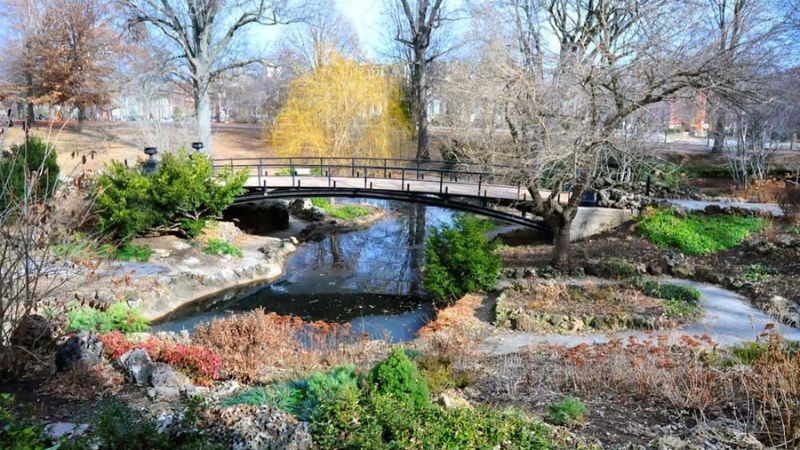
If you’re visiting and want to learn more about the history, there’s a self-guided tour!

Bars & Restaurants You’ll Love
There are several notable restaurants, cocktail bars, and brunch spots. These social establishments embrace the distinct charm that defines this area.
Bailey’s Chocolate Bar: A dessert and martini bar, this place has been a St. Louis favorite since its opening in 2004, making it an ideal spot to celebrate any occasion.
Eleven Eleven Mississippi: A new take on rustic Tuscan cuisine. This restaurant has become a destination for foodies. They also have more casual dishes and serve lunch.
Polite Society: Serving dinner and brunch, this restaurant offers a welcoming environment and an eclectic American menu.
Planters House: An upscale seasonal bar and restaurant with an inviting vibe.
Clementines Naughty and Nice Creamery: Known for its boozy ice cream, unique flavors, and vegan options.
Square One Brewery and Distillery: This establishment features a wide selection of spirits, beer, and elevated pub food in a restored historic building!
Park Avenue Coffee: Every neighborhood has a coffee shop. This one features an outdoor area and the local dessert favorite, Gooey Butter Cake.
33 Wine Shop and Bar: A great place for wine lovers with a knowledgeable and friendly staff to help with selections.

Community Events
The Lafayette Square neighborhood association is very active.
Look out for these community events:
Summer Concert Series at LaFayette Park: Bi-weekly concerts at the Betsy Cook Pavilion. A free event where attendees are encouraged to bring a lawn chair or blanket.
Annual Light Up the Square & Holiday Pet Parade: This whimsical event occurs every winter at LaFayette Square Fountain Plaza. It features holiday music, food/drink, a pet parade, and tree lighting.
Holiday Parlor Tour and Holiday Market: Taking place annually in December, this event includes carriage rides, a holiday market, and trolley tours. (Tickets tend to sell out)
Trick or Treat in the Square: This Halloween tradition offers an old-fashioned trick-or-treat experience. Residents participate by decorating their houses and handing out candy.
A Brief History of Lafayette Square St. Louis
This neighborhood began with the 30-acre Lafayette Park.
The name “Lafayette” commemorates the famous French general from the Revolutionary War, Gilbert du Motier, Marquis de Lafayette.
The park was an extension of the St. Louis Commons, which was reserved for public use as a pasture and farmland.
At first, this area was considered ‘too remote’ for anyone to build a home. However, by 1860, St. Louis experienced a 900% population growth.
From 1860 and the two decades following, the Lafayette Square neighborhood became trendy, attracting notable politicians and businessmen who chose to build their homes here.
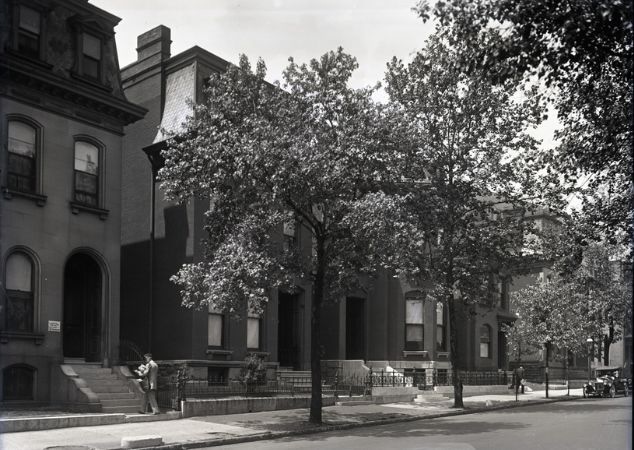
In the 1890s, many families started moving further west.
In 1896, Lafayette Square suffered a blow when a devastating tornado hit. Instead of rebuilding, numerous families joined the Western migration.
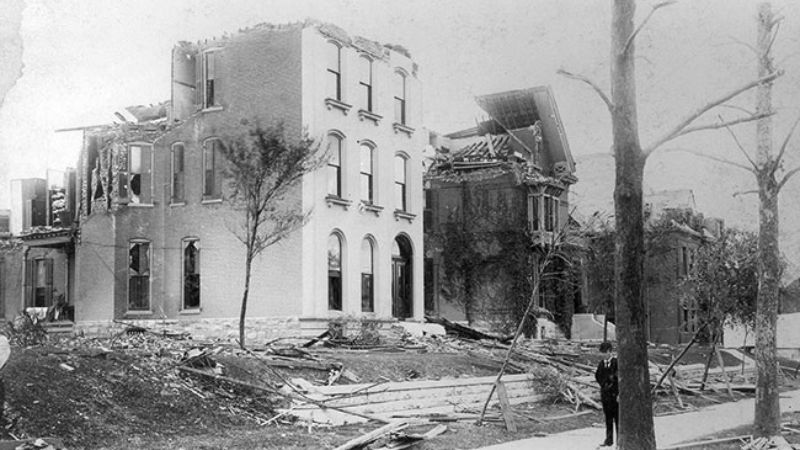
By the 1920s, Lafayette Square was a mere shadow of its former glory.
Many homes were converted into multi-family dwellings and left to deteriorate, with some buildings being taken down completely due to neglect.
The Neighborhood Makes a Comeback
Fast forward to the 1960s, a small group of passionate residents formed the Lafayette Square Restoration Committee, determined to restore these once-grand homes.
- The City of St. Louis recognized Lafayette Square as its first historic district in 1972
- In 1973 Congress placed Lafayette Square in the National Register of Historic Places.
- Historic Codes now protect the neighborhood’s aesthetic





